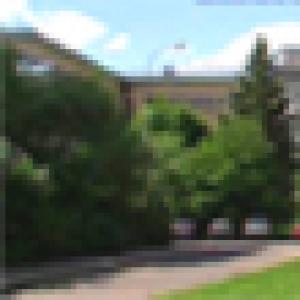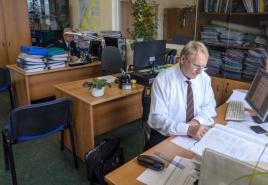When the comet arrives. The Amazing History of Halley's Comet
> Halley
Halley's Comet, photographed in 1986
- solar system comet: orbital period, photo, research history, year of Halley's comet, eccentricity, when it arrives, semi-major axis.
Halley's Comet is a short-period comet that comes to our planet every 75 years. The last time we saw her was in 1986. If you're wondering when it will fly back, then the Earth expects its return in 2061.
The comet was named after Edmund Halley, who investigated its arrival in 1531, 1607 and 1682. He realized that all three comets were the only returning object. So he was able to predict that 1758 should be taken as the year of Halley's comet.
Halley did not live to see this moment, but his conclusions turned out to be correct. Moreover, his calculations showed that a certain category of comets constantly returns to the Earth. In 1986, telescopes on Earth tracked the arrival of Halley's comet, and some spacecraft even planned to take samples.
It is difficult to observe because the period of Halley's comet spans decades. Therefore, scientists concentrate on other objects in order to compare and infer class characteristics. For example, the analysis of 67P/Churyumov-Gerasimenko showed that the composition of water on comets differs from that of the earth.
History of Halley's Comet
The first record of a comet was left in 239 BC. e. It is listed in the Chinese chronicles of Shin Shi and Wen Xiang Tong Khao. The ancient Greeks left a record in 466 BC. e. The return was recorded in Babylon in 164 and 87 years. BC. These texts are important because they allow you to study its orbital path in the past.

The arrival in 1301 inspired the painter Giotto to paint The Star of Bethlehem, which tells of the victory of William the Conqueror. At that time, scientists thought that every event indicates the arrival of a new object. They were often seen as harbingers of catastrophes. This is also noticeable in Shakespeare's play "Julius Caesar", where one of the lines says that comets mark the death of kings.
Detection of the periodicity of Halley's Comet
Even during the life of Shakespeare, astronomers were inclined to think that the Sun is at the center of the solar system. Many years passed until a whole powerful concept was established, forcing us to take a fresh look at our place in the Universe (the heliocentric system).

In 1705, Edmund Halley finished studying 24 comets and published the Astronomical Report of Comets, where he noted the objects that arrived in 1337-1698. Three of them coincided in orbits and other parameters, and he suggested that they were all a single object. He also calculated that her arrival should be expected in 1758.
The comet arrived on time and was followed by inspired scientists from all over the world. Halley's comet is shown in the photo below.

The return of the comet in 1910 was especially impressive, because it approached us by 22.4 million km. It was in this year that we received her first photo. It's amazing that Mark Twain accurately predicted his own death. He wrote that he arrived with the comet in 1835 and would leave on the next arrival. It happened on April 21, 1910.
space age
In 1986, mankind was able to use spacecraft for the first time in research. And it was a good moment, because she came close to the planet. To the comet went several vehicles, named "Halley's Armada". The Soviet-French mission Vega-1 and 2 went to the object and one even managed to capture the core. Two probes also flew from Japan.
Photos of Halley's comet were also received from NASA's International Cometary Explorer, which has been operating since 1978. The photographs were taken at a distance of 28 million km.
The arrival of the comet marked a tragic event. The crew of the Challenger STS-51L planned to follow her. But on January 28, the ship exploded during takeoff and 7 astronauts died.
Before the re-arrival to wait another tens of years, but we can follow the cosmic remnants in space. This is the Orionid meteor shower in October.
In 2061, Halley's Comet will be on the same side of the Sun as the Earth and will be much brighter. Scientists believe that its periodicity is still doubtful, because a collision with any object will push it away for thousands of years.
According to the prediction, its brightness should reach an apparent value of -0.3. There are also objects included in the "comets of the Halley family." They converge in orbital characteristics. But there are inconsistencies, which means they may have a different origin. Perhaps these are members of the Oort cloud or created from the centaurs (between Jupiter and the Kuiper belt).
In anticipation of the comet, scientists are not sitting idly by. In 2014-2016 we had the amazing opportunity to visit Comet 67P/Churyumov-Gerasimenko and analyze the samples. In the same way, the researchers studied 81P/Wild and 9P/Tempel.
Photos of Halley's Comet
Halley's comet in 1986

Comet in Table Mountain Observatory Survey

On January 13, 1986, Halley's Comet was photographed by James Young from the Table Mountain Observatory using a 24-inch reflecting telescope. The stripes created in the exposition are the stars in the territory of Aquarius. A coma and a charged ion tail stretching for 725,000 km stand out in the image.
Comet in 1910

Comet reviewed by Giotto

On March 13, 1986, the multi-color camera of the Giotto apparatus recorded a cometary nucleus at a distance of 600 km.
Halley's Comet in the Diamond Mountain Survey

Halley's comet could be captured

Halley's Comet as seen by Mount Wilson

| Discoverer: | Observed in ancient times; named after Edmund Halley, who discovered the periodicity of the appearance |
| Opening date: | 1758 (first predicted perihelion) |
| Alternative designations: | |
| Orbit characteristics | |
|---|---|
| Eccentricity | 0,9671429 |
| Major axis | 2.66795 billion km (17.83414 AU) |
| Perihelion | 87.661 million km (0.585978 AU) |
| Aphelion | 5.24824 billion km (35.082302 AU) |
| Period of circulation | 75.3 g |
| Orbital inclination: | 162.3° |
| Last perihelion: | February 9, 1986 |
| Next perihelion: | July 28, 2061 |
| physical characteristics | |
| Dimensions: | 15×8 km, 11 km (average) |
| Weight: | 2.2 10 14 kg |
| Average density: | 600 kg/m³ (estimates range from 200 to 1500 kg/m³) |
| Albedo: | 0,04 |
| Spawned meteor showers | eta Aquarids, Orionids |
On the eve of the new decade of the twentieth century, the world community has undergone another serious shake-up. The reason was not war and not another revolution. This time, the threat did not come from people, but directly from the sky: in 1910, another appearance of Halley's comet was expected.
The English scientist Edmund Halley at the beginning of the 18th century became the first astronomer who managed to calculate the orbit of a comet and, accordingly, predict the appearance of a celestial body near the Sun. Bright, clearly visible from the Earth with the naked eye, with a relatively short return period (75-76 years), Halley's comet quickly became the most famous "celestial wanderer". According to the calculations of astronomers in May 1910, the Earth had to pass through the comet's tail, stretching for tens of millions of kilometers. In the latest photographs of the comet's spectrum, bands of cyanide (synerode), a poisonous gas, were found. He became well known to the public from criminal reports: potassium cyanide was already a popular suicide poison in Europe. Therefore, the return of this comet has never been expected with such interest and anxiety.
Almost nothing was known about the origin and physical properties of the comet's tail; scientists, along with journalists, wondered about the possible consequences. The comet has become not just a traditional herald of troubles, but also their direct cause: scientific ideas were superimposed on archaic ideas.
But the panic in society began long before the appearance of the comet-poisoner. At the very beginning of 1910, in the atmosphere of Halley's anxious expectation, another bright comet suddenly appeared in the sky of the Southern Hemisphere, visible even in the daytime sky (the Great January Comet C / 1910 A1). In the press, confusion begins: no one knows where Halley is, which of the comets found poison in the tail - and in general, whether these comets are different or one. "Petersburg leaflet" at the end of January stated: "At present, the overwhelming majority of foreign newspapers state that comet A. is precisely Halley's comet, which appeared a year earlier than it was calculated by astronomers." Astronomers themselves, of course, have repeatedly stated that these are two different comets.
Comet and the world
The news of the poisoned tail and the unexpected appearance of the second comet fueled the already heated debate and speculation that arose around the new phenomenon. Every now and then, new destructive forces were attributed to comets - floods in France, snow storms in the Ryazan region, or even stopping trams.
Correspondent Berliner Tagebl. telegraphs about an amazing phenomenon that took place near Florence. Between Valla and Sampiero a shower of small, round, incandescent meteorites began to rain. Roads, fields and vineyards are completely covered with them. Most of the plantings have died. After this fiery rain, the clouds parted and a shining comet was visible. The population in fear serves prayers.
Heavenly power is with us!
Something is wrong in the world
Listening to us is no longer nice
Talk about a new comet!
Waiting for Halley's comet.
Suddenly another appeared;
Secret mysterious way,
Shines, shining in the sky.
<...>
How will we manage?
Trouble is getting closer and closer.
Somewhere the ground is shaking
And the flood in Paris.
the eiffel tower sank,
Those people walk in anxiety;
That's right, the comet hit
Tower tail on the road!
The approach of comets has become a fertile topic for the periodical press - in many ways, the general panic attacks were provoked by the press itself. Newspapers reported on mass confessions in Parisian churches, on miners' strikes in the United States, on the growing number of lunatics in Italy, and on French charlatans who had established the production of means to escape the comet's poison gas - bottles of air, special "anti-comet" tablets and even umbrellas. Entrepreneurial people in England offered those who wished to rent a submarine for rescue. The comet was the culprit.
Comet in Russia
One of the correspondents of the newspaper "Morning of Russia" later stated:
“We can proudly admit that the “Russian barbarians”, as our Western European friends like to call us, turned out to be much more cultured than our European neighbors in the matter of Halley's comet ... No suicides, no prayers, no unrest - in a word, not a hint of what will accompany - expectation of the "end of the world" in other countries. Russian society and even ordinary people reacted soberly and calmly to all expectations, which in no way corresponded to reality. Now, everyone says, you can safely live another 75 years before, perhaps, a new meeting of the comet with the earth.
In fact, the January comet in Russia also caused various speculation and tantrums.
“On January 16, at 5 pm, a comet appeared in the north-west of the sky, it occupied a vertical position, the tail was narrow, turned upward, somewhat curving towards the south; yellowish color.<...>The comet caused a lot of talk among the peasants: old people, especially women, consider it an omen of the imminent doom of light. Literates argue that according to the Gospel it has not yet come out: they recognize the decrease in faith and love between people, the multiplication of vices and disasters is obvious, but the Antichrist has not been born.
As in the West, enterprising people also took advantage of the approach of comets for their own benefit. In Moscow, the sect of Brother John became active again Brother John- Ivan Churikov (1861-1933), leader of the spiritual movement of the Churikovites. He preached the idea of spiritual salvation through giving up alcohol and smoking. He opposed the census, was repeatedly imprisoned, founded a colony of teetotalers near Vyritsa. In 1929 he was arrested by the OGPU., who now preached the secret knowledge of comets. It was reported that in Tver the appearance of the comet had already been used by some clever entrepreneurs. On the bustling streets of the city, suspicious individuals are selling the pamphlet Halley's Comet and the End of the World.
“Brother John hosted a crowded meeting the other day on ‘thumping topics’. Here are some excerpts from his sermon. “There was a congress about the green serpent, but nothing came of it, because the green serpents came to it.” “Now, they say, some kind of tail-comet will fly in, they assume that it will touch the Earth, and I say: the stupid people themselves are hurting their heads for Pushkin and Lermontov (!)“.
A thousand-strong crowd of naive, mostly women, tearfully sobs, assenting to Brother.
The business of Bratz, apparently, is expanding: improved ventilation and electric lighting are arranged in the room.
 Halley's Comet over Fifth Avenue and Broadway in New York. 1910 postcard Steve Shook/Flickr
Halley's Comet over Fifth Avenue and Broadway in New York. 1910 postcard Steve Shook/Flickr On the other hand, many members of the scientific community did their best to reassure the population. Various public lectures gained great popularity, where a certain professor A. A. Ivanov assured the audience that the comet was safe and would fly by at a respectable distance from the Earth. Often, information about the comet received from newspapers or public lectures backfired. For example, information about the poisonous gas contained in the tail of Halley's comet sometimes took on absurd forms.
“Yesterday and the third day the townsfolk repeatedly contacted the editorial office by telephone, claiming that they felt a kind of “smell of alcohol” in the air, and timidly inquiring whether this strange phenomenon was connected with the approach of Halley's comet.
Although the smells of Halley's comets have not yet been investigated, it is unlikely that a heavenly body can still "reek of vodka".
If the noses of our interlocutors on the phone do not hallucinate, then the alcoholic smell is more likely to be explained by the increased preparation of alcohol for the holiday.
Celestial mechanics here, in any case, have nothing to do with it.
The arrival of comets inspired the resolution of everyday problems. So, one young girl placed her ad in the marriage newspaper with the headline “In front of the comet”, and another, dressed as a comet, participated in a costume contest. However, the resourceful Mrs. Zhukova had to be content with only second place: the first was awarded to Mrs. Gaidarova for the pumpkin outfit.
The appearance of Halley's comet also served as a good occasion for witty exercises. A caricature of one of the leaders of the nationalist movement in Russia, an employee of the Novoye Vremya, Mikhail Menshikov, with the caption: “If a comet collides with the Earth, you will have to write an article about the dominance of foreign elements.” Feuilletonists also delighted the audience with their works. Vladimir Golikov, under the pseudonym Wega, published a series of miniatures in the newspaper Voice of Moscow, humorously highlighting the reaction of leading newspapers to the comet. Among them, the Cadet newspaper "Rech" allegedly stated the following about the comet:
Comet Appearance
Gives no illusions to the press
And it doesn't signify
Relief of repression.
The more radical Novoye Vremya, which was sympathetic to nationalist circles, allegedly considered the appearance of the comet a foreign provocation:
Comet is coming...
We know these approaches!
In this, the neighbors, probably
Foreigners are to blame!
They say they intercourse
Started with the vault of heaven
And Halley's comet
Poisoned with synergy.
In the pre-reform period
They wouldn't be given indulgence
And now, under the Third Duma,
The authorities are dormant.
There were also texts in the spirit of useful advice to the population, where the apocalyptic theme was surprisingly combined with a cheerful intonation:
We have a minute dear:
The world is coming to an end!
Bulga stands on the ground
For this reason.Soon we'll have a comet tail
Throws on the shoulder blades.
Don't lend money
Give away leftovers!
Writers about the comet
The news of the comet disturbed not only the mass reader of newspapers, but also the metropolitan intelligentsia, therefore it is not surprising that not only “poems in case” from humorous newspapers, but also very serious texts of famous writers were dedicated to the comet. Until 1910, the comet was already quite a traditional poetic image. However, until the news of the disastrous synergy spread in society, this image was very attractive, but still quite innocent. In most cases, the comet served, for example, as a metaphor for describing love relationships. So, in Maximilian Voloshin's wreath of sonnets "In the worlds of love, unfaithful comets ..." (1909), consisting of 15 poems, the comet was the central image, but did not carry with it any threat:
In the worlds of love, unfaithful comets,
Through the heavenly spheres flickering stozhar -
Clubs of fire, raging fire,
Wandering lights of universal storms, -We carry far...
Everything changed in 1910, when rumors spread about a catastrophe threatening the Earth. The eve of the comet's return is marked by an explosion of references to it in poems. The comet has become a steady sign of danger and doom. In the poems of Nikolai Gumilyov, the comet appeared several times; in Mikhail Zenkevich, she appeared in the form of a poisonous snake ("Gloomy God"); David Burliuk was saturated with poison ("Stans").
The symbolists were most sensitive to the approach of the comet. For them, it was not just a potential threat, but also an undeniable sign of the end of the world. Sergey Sokolov (Krechetov) described the state of a person who was preparing to meekly accept death from a comet (“The Last Man”):
Comets are a sign, like snake rings,
Crowns the sky. So. It's time.
I lie, motionless, numb,
By the cold fire...
Igor Severyanin, an ego-futurist poet, despite his aesthetic disagreements with the Symbolists, was in solidarity with them on this issue. Moreover, he was convinced that the comet is not just a symbol of the end of the world, but also a punishment for people for all their sins, which he expressed in his poetry “Sextina. A presentiment is more tormenting than a comet ... ":
How divinely enlightened you are in the darkness!
Prophetically vague signs;
They are bonfires, but those bonfires are everywhere...
Folk genius, closed in need,
One managed to know the comet's dream
And talk about the vengeful star.I see death coming in a star
And, if you are evil lost in the darkness,
The prophet is a poet of pagan signs,
You talk to me about the horrors of the comet,
I merge with you and about need
I want to forget: why? Because death is everywhere!
She's coming, she's already everywhere!I wing hello to the punishing star -
She brings an end to earthly need...
Like ten suns, sparkle, star, you are in the darkness,
Blind life and justify signs
Comet enchanting oblivion!
Block and comets
Alexander Blok could not remain indifferent during these unrest in 1910. The appearance of comets corresponded to his symbolic picture of the world, in which, after the revolution of 1905, the poet and mankind were on the verge of a mystical catastrophe. Comets were both heralds and the cause of it - the embodied element. Blok was especially inspired not by Halley, but by the unexpected Great January Comet. It is about this first comet that the poet writes to his mother on January 11 (the comet is not yet visible in the Petersburg sky, the city is filled with rumors):
“Do you know that besides Halley’s comet (a safe one like Nat[alya] Nik[olaevna] [Volokhova]) another unknown one is coming – a real stranger? Its tail, consisting of cinerod (hence the blue gaze), can poison our atmosphere, and all of us, reconciled before death, will sweetly fall asleep from the bitter smell of almonds on a quiet night, looking at a beautiful comet ... "
In the printed speeches of astronomers devoted to the new comet, there was no mention of cyanide - it is he, like potassium cyanide, that smells of bitter almonds - there was no mention. But this is not important - Halleya, according to Blok, could not be a "stranger" simply because she is familiar to everyone: her orbit is known, returns to the Sun are predicted. The January comet suited the role of an unexpected guest much better. Since the mid-1900s, the image of a comet in Blok's lyrics has been associated with a female character - through Pushkin's "Portrait" ("Like a lawless comet / In a circle of calculated luminaries") and through Apollon Grigoriev's "Comet" ("The comet will fly in the wrong line"). The stranger from Blok's drama of the same name is the "falling maiden star"; the image of the comet's tail can be seen both in the "mourning feathers" from the poem "The Stranger", and in the plume, "blizzard tambourine", fan from "There, in the howling cold of the night ...". The image of a female comet appears especially insistently in the Snow Mask cycle (1907) (“You alone will rise over the whole desert / Expand the plume of the comet”). The addressee of the "Snow Mask" itself, actress Natalya Nikolaevna Volokhova, with whom Blok fell in love in winter
1906-1907, did not accept the life-building practices of the poet, refusing to take the place of the Stranger. In a letter to his mother, Blok jokingly cancels the addressing of the cycle (Volokhova = Halley's familiar comet) and finds a new motivation for the image of the heroine through the synerode: "hence the blue gaze" (the poet recalls in the letter the poem "A plume spattered with stars ..." from "The Snow Mask" and line "blue, blue, blue eyes").
In February 1910, Blok wrote the famous "Black Raven in the Snowy Twilight ...", in which comets and earthly passion unite in the images of a "terrible world":
Scary world! It is too small for the heart!
In it - your kisses are nonsense,
The dark haze of gypsy songs,
Hasty flight of comets!
However, the Great January comet will leave the earth's sky without any incident, and Blok will already meet the May Halley without much enthusiasm. On May 12 in Shakhmatovo, Blok writes in his notebook:
“This morning I got up from a warm bed at four o'clock in the morning to look at the comet. It was a gray morning, the fog swirled ...
I did not see the comet, but I saw how [the tenant] Egor, who got up with his pregnant wife, hastily and furtively stuffed a wagon of straw ... how the sheep came out - and rushed without a look at our clover, unfed hens crawled out ... three unfortunate calves came out, hobbled with bucket pregnant Olga.
Along with Blok's disappointment in comets that did not bring their symbolic potential to life, the motifs in his poetry, which were united for a short time, also disintegrate. The “comet” theme is summed up by the famous poem “Comet” (“You threaten us with the last hour ...”), the first edition of which was written in September of the same 1910, when the unrest around Halle finally subsided. The comet in the poem is neutralized through comparison with human civilization - the Earth turns out to be the same comet: "Our world, spreading its tail of a peacock, / Like you, is filled with a riot of dreams." Both the elements and civilization are equally overcome by the hero:
No! Death is not terrible for the hero,
When the dream is crazy!
Even if you are above your head
Exude the sweet poison of the tail,
And menacingly silent behind
Monotonous screw crack. Cit. according to the first edition.
This is one of Blok's rare poems of the 1910s, where victory over catastrophe and death triumphs - both The Aviator (1912) and the opening stanzas of Retribution will be performed in a completely different intonation. But in 1910, the cyanide from departed comets was found to be harmless.
HALLEY'S COMET, the only one of the short-period comets (orbital period approx. 76 years), easily accessible for observation with the naked eye.
Relatively small nuclei of comets, consisting of ice interspersed with dust particles, approaching the Sun, are enveloped in a huge atmosphere (coma) of gas and dust hundreds of thousands of kilometers long. Intense solar heating vaporizes ice from the comet's nucleus, expelling gas and dust into its surrounding atmosphere. Then, under the pressure of solar photons and high-speed particles of the solar wind, this substance flies away in the opposite direction from the Sun, forming a gas-dust tail of a comet, reaching a length of millions of kilometers.
In March 1986, Halley's comet was observed not only by numerous amateur astronomers and professional scientists, but also by five international spacecraft ( see also SPACE PROBE). The Japanese probes "Sakigake" and "Suisei" observed a huge hydrogen cloud surrounding the comet, and investigated the interaction of the comet with charged particles of the solar wind. The Soviet probes "Vega-1 and -2" passed on March 6 and 9 at distances of 8,871 and 8,014 km from the comet. On March 14, 1986, the Giotto probe of the European Space Agency passed closest to the nucleus of comet , only 605 km. Television images transmitted by European and Soviet probes showed the comet's pitch black nucleus. Comparing ground and space observations of gas and dust surrounding the core, scientists concluded that it is about 50% ice, and the rest is dust and other non-volatile substances. Ice is mostly water (80%) and carbon monoxide (10%), with the rest being formaldehyde, carbon dioxide, methane, ammonia and hydrocyanic acid. The non-volatile part, mainly represented by micron-sized dust particles, consists of either rocky matter or light hydrocarbons.
Externally, the nucleus of Halley's comet is a potato-shaped object measuring approx. 14ґ 10ґ 8 km. Its very black crust of carbonaceous (organic) matter is in many places covered with faults, through which the subcrustal substance is visible, consisting mainly of water ice interspersed with dark dust grains. Since the comet's nucleus rotates around its axis with a period of several days, this ice evaporates under the influence of sunlight and turns into gas, which, flying out of the nucleus, captures dust particles with it. It was this core, like a small, dirty iceberg, that supplied all the gas and dust that formed the vast atmosphere and tail of the comet.
Halley's comet was the first to be predicted to return periodically to the central region of the solar system. Using the mathematical apparatus developed by I. Newton, his colleague E. Halley (16561742) calculated the parameters of the orbits of 24 comets observed by astronomers in previous years. It turned out that the comets that appeared in 1531, 1607 and 1682 had similar orbits. Halley suggested that in reality it was one and the same object, and predicted that the comet now bearing his name would return to the Sun at the end of 1758 or at the beginning of 1759. When at the end of 1758 the German amateur astronomer I. Palich discovered the comet in the sky, this was a triumph for Halley's calculations and Newton's underlying laws.
On its long path along the orbit, Halley's comet falls under the gravitational attraction of the planets it passes by, and approaching the Sun, it feels a weak force return from the gases evaporating from the surface of its nucleus. Under the influence of these perturbations, the comet's orbital period can change for several years from one of its appearances to the next. Calculating the past motion of Halley's Comet allows us to calculate each of its 30 appearances between 240 B.C. and 1986. Its next two solar transits are expected on July 28, 2061 and March 27, 2134. The comet's 1986 flyby was a bit of a disappointment to observers because it didn't get close enough to Earth. Its minimum distance from our planet on April 10, 1986 was 63 million km. Unfortunately, during the return in 2061, the comet will not come closer to the Earth than 71 million km. This will happen on July 29, 2061. And the return of 2134 will be more impressive, since the comet on May 7, 2134 will be at a distance of 13.7 million km from the Earth.
The very first mention of the appearance of a comet is considered to be a record of observations by Chinese astronomers dating from about 2296 BC. This phenomenon was considered a harbinger of misfortune, illness and all sorts of cataclysms. Unable to study them, Aristotle tried to explain these phenomena as atmospheric. Deep research began in the Middle Ages.

The famous astronomer of that time, Regiomontanus, was the first to study the structure of data at that time still completely unexplored cosmic bodies. A little later, the Danish astronomer Tycho Brahe ranked them among the celestial bodies.
Project Vega

This project was developed by Soviet scientists, and consisted of 3 phases: the study of the surface and dynamics of the atmosphere of Venus, and the passage near Halle. The spacecraft was launched from Baikonur in 1984.

Instruments for studying the nucleus of a comet were located on moving platforms, which automatically tracked the position and turned after it.

Comet nucleus, visible ejection of material from the surface
Studies have shown that the Halley core has an elongated irregular shape with a very high temperature and low reflectivity. Measurements of the chemical composition showed that most of the gas is water vapor.

Based on this, it was concluded that her head consists of frozen water interspersed with metal molecules and silicates.
During the foreseeable past of mankind, many comets have been discovered. Each of them has its own characteristics and, of course, is worthy of our attention. We will try to get acquainted in more or less detail with, first of all, Halley's comet.
By the way, sometimes you can hear that this comet was discovered by the great Italian scientist Galileo Galilei. It is not true. The comet is named after the English astronomer, diplomat and translator Edmund Halley.
The 26-year-old astronomer Halley discovered a very interesting comet in the sky, which greatly increased its brightness in a few days. At the same time, a long tail was clearly visible. Halley carefully made observations of the comet, tried not to miss a single evening. This turned out to be very useful, since the comet faded very quickly, becoming inaccessible for further observations.
In those distant times, it was believed that all hitherto observed comets came from interstellar space and returned there again. It is difficult to say how long this situation would have lasted if not for one major event in the history of mankind.
The brilliant naturalist, great physicist and mathematician Isaac Newton completed an outstanding scientific work related to the analysis of the motion of the planets around the Sun, and formulated the law of universal gravitation: the force of mutual attraction between two bodies is directly proportional to the product of their masses and inversely proportional to the square of the distance between them. In other words, the more massive the bodies and the smaller the distance between them, the stronger they are attracted to each other.
According to this law of nature, all the planets move around the Sun not in an arbitrary way, but strictly in certain orbits. These orbits are closed lines. Recall that closed lines are, for example, a circle, an ellipse, that is, lines whose beginnings merge with ends.
The orbits of the planets are ellipses. True, these ellipses are not very elongated. For example, the orbit in which our Earth moves is almost circular.
Halley turned to Newton with a proposal to consider how comets should move in accordance with the law of universal gravitation. Recall that there was an idea that comets move towards the Sun and away from it along rectilinear trajectories.
Apparently, Newton considered Halley's request serious, since he began research with great eagerness. According to the results of these studies, comets, depending on various conditions, should describe either an ellipse, or a parabola, or a hyperbola near the Sun.
To imagine what a parabola looks like (if you don’t remember this from a high school course), draw an elongated ellipse with a pencil, then erase half of it with an elastic band, and continue the two protruding lines to the edge of the sheet and imagine that these lines go to infinity , never crossing. A parabola can also be drawn using a flexible willow twig. Take the twig with both hands at both ends and gently, so as not to break, bend it until the ends of the twig become parallel, and then slightly push it apart - you get a parabola. Now push the ends of the twig until an almost right angle is formed. This will be hyperbole.
Thus, you see that, unlike the ellipse, both the parabola and the hyperbola are not closed lines: their ends never connect to their beginnings.
So, according to Newton, comets move either in elliptical or parabolic or hyperbolic orbits, with the Sun at the focus of each orbit. The focus of the curve is some point F lying in the plane of this curve. Foci of parabolas, hyperbolas and ellipses are located near the roundings of these curves. It is obvious that a parabola and a hyperbola have one such point each, and the Sun is located in it, and the ellipse has two such points, and the Sun is located in one of them.
We talk about this in such detail to give you some food for thought. If you put down your book now and think a little, you will see for yourself what an important method of research Newton discovered. It is enough for astronomers to calculate the comet's orbit, and this orbit itself will "tell" whether the comet will return to the Sun or leave it forever.
It is easy to understand that if the orbit turns out to be parabolic or hyperbolic, i.e., not closed, then a comet with such an orbit will never return.
It is quite another matter if the orbit turns out to be elliptical. Since the ellipse is a closed line, the comet must necessarily return to the point in space where it has already been observed from the Earth. When will this happen? Then, when the comet makes one revolution around the Sun.
And how much time will it take for this? For example, the Earth makes one revolution around the Sun for every 365 days, that is, for a year. And Jupiter, which is much farther from the Sun than the Earth, makes one revolution in 4329 days, that is, almost 12 Earth years.
How long does it take for a comet moving along an ellipse to make one revolution? It depends on various parameters of the ellipse, in particular on the distance between its foci. The smaller this distance, the faster the comet will make a revolution around the Sun.
It must be said that calculating the orbit of a comet from observational data is a very difficult task. Newton understood this very well, and therefore he calculated the first orbit himself.
In those distant times, there were no computers, no microcalculators, or even adding machines. All calculations were done manually. For this, special bulky tables were compiled, and the calculations themselves could continue for many months, and sometimes even years.
The comet's orbit, which Newton calculated, turned out to be elliptical, and he concluded that the comet must return.
Inspired by Newton's scientific feat, Halley began to collect information about previously observed comets. It was, of course, a very difficult task. It was necessary to find ancient chronicles, manuscripts of astronomers from various countries, which provided the coordinates of comets in the sky and fairly accurate data on the time of each observation.
Halley managed to collect data on many comets, and he began the most difficult and exhausting work - the calculation of their orbits.
By 1705, Halley had calculated the orbits of 20 comets that were observed after 1337. But the tireless scientist did not stop there. He began to analyze the results of his unique work with great zeal. What was his satisfaction when he found that the orbits of the comets of 1607 and 1682 turned out to be remarkably similar to each other.
Is it the same comet? If so, then it makes one revolution in 75 years, i.e., this comet should have been observed 75 years before 1607. And indeed, Halley found out that the comet of 1531 moved in exactly the same orbit!
Have you already guessed Halley's next step? Yes, since the last observation of this comet took place in 1682, then its next appearance should occur in 75 years. It was Halley who predicted that in 1758 the comet would return to the Sun again.
Halley did not live to see the day of his triumph. He died in 1742 at the age of 86.
It must be said that the paths in science are never smooth. On the contrary, they are simply strewn with difficulties, contradictions, disappointments, and not everyone can overcome them. This cup did not pass and Halley. While still analyzing cometary orbits, he noticed that the return of a comet sometimes occurs not exactly after 75 years, but with a difference of several months and even one year. What was the matter, neither Halley nor his contemporaries could say for sure. Therefore, Halley, predicting the appearance of a comet in 1758, could not name the month when the comet would be clearly visible from Earth.
And then came 1758. Astronomers leaned close to the eyepieces of their telescopes, hoping to be the first to spot the comet and inform the world that the time had come to look at the miracle of scientific prediction and pay tribute to the unforgettable Halley. But their expectations were in vain. The year 1758 passed and the comet did not appear.
What happened? Was Halley's prediction wrong, or was the comet too late?
As always, society was divided into two camps. Most of the skeptical people, for whom the gratuitous work of astronomers seemed an eccentricity, if not stupidity, frankly laughed at the naivety of the fooled public. More educated people, and especially astronomers, really wanted Halley's prediction to come true. But... the comet didn't appear.
What could delay her on the way? Apparently, the influence of the large planets Jupiter and Saturn - many scientists have come to this opinion. What was left to do? Wait? After all, there were no methods for taking into account the influence of planets on the motion of comets.
Truly, the ways of science are inscrutable! The best astronomers of that time ransacked every corner of the firmament, but luck passed by them like water through a sieve. The first to see the comet was an unknown German peasant by the name of Palich, who on the night of Christmas on December 25, 1758 did not dance and sing around the Christmas tree, but carefully peered into the starry sky, looking for a heavenly wanderer.
Halley's prediction came true.
The comet passed through perihelion on March 13, 1759. The public understood that the victory was complete.







